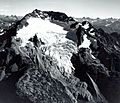Jack Mountain facts for kids
Quick facts for kids Jack Mountain |
|
|---|---|

Nohokomeen Glacier on the northwest face in 1966
|
|
| Highest point | |
| Elevation | 9,075 ft (2,766 m) NAVD 88 |
| Prominence | 4,211 ft (1,284 m) |
| Geography | |
| Location | Whatcom County, Washington, U.S. |
| Parent range | North Cascades |
| Climbing | |
| First ascent | 1904 by E.C. Barnard |
| Easiest route | Climb with exposure, class 4 |
Jack Mountain is a very tall mountain in Washington state. It ranks as the 17th highest mountain there. It's also special because it's one of only ten tall mountains in Washington that aren't volcanoes.
This mountain stands dramatically over the south end of Ross Lake. It rises about 7,450 feet (2,271 meters) from the lake's edge in just a few miles. A large glacier called Nohokomeen Glacier covers much of its upper northern slopes.
Contents
History of Jack Mountain
Jack Mountain was first described in 1859 by a surveyor named Henry Custer. It got its name from a prospector, or gold seeker, named Jack Rowley. He used to work in the Canyon Creek area nearby.
The first time someone officially climbed Jack Mountain was in 1904. A mapmaker named E.C. Barnard was the first to reach its top.
The Geology of Jack Mountain
The rocks that make up Jack Mountain tell a long story about Earth's past.
Rock Types of the Mountain
Jack Mountain is mostly made of two main types of rock: metavolcanic and metasedimentary rocks. These rocks are part of something called the Hozameen Group.
The most common rock you'll find is Greenstone. This rock formed a very long time ago, between the Jurassic and Permian periods. Most of the rocks on the surface have been worn down by water and glacier ice over many years.
Closer to the bottom of the mountain, especially in the Devils Creek area, you'll find different types of rock. These include orthogneiss, ultramafic rock, phyllite, tonalite, glacier drift, diorite, and schist.
How Jack Mountain Formed
Jack Mountain was created by powerful forces deep within the Earth. It has a small thrust fault and a few other normal faults. A thrust fault is where one block of rock slides up and over another. Luckily, these faults don't cause earthquakes here.
The mountain formed when the older Hozameen Group rocks were pushed up and over the younger Harts Pass formation. This likely happened because of a large fault to the west called the Ross lake Fault. The lower parts of the mountain on the western side were formed by something called the Ruby Creek Heterogeneous plutonic belt.
Geographical Features
Jack Mountain is surrounded by many interesting natural features:
- Nohokomeen Glacier: This large glacier fills the northwestern side of the mountain.
- Northeast Glacier: A steep and heavily cracked small glacier on the northeast side.
- East Glacier: A small glacier tucked away on the east side.
- Northwest Glacier: A small glacier that hangs on the west side of the summit ridge.
- Crater Creek: This is the main stream that drains water from the south side of the mountain.
- Devils Creek: This is the main stream that drains water from the north side.
- Nohokomeen falls: A waterfall on May Creek that flows over a steep rock face.
- Roland Creek: Located on the very steep west side, this creek and its smaller branches have many waterfalls.
Images for kids




